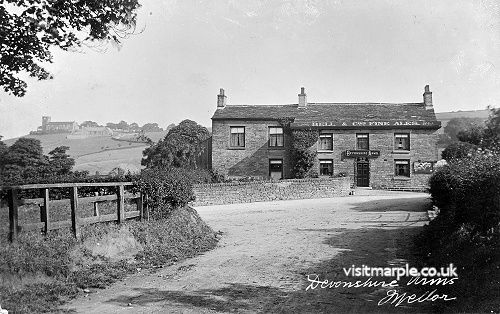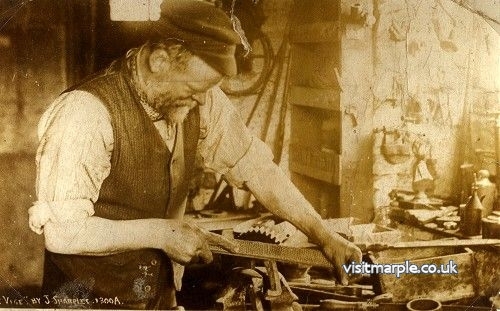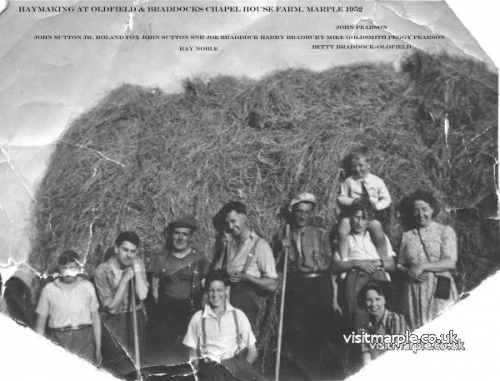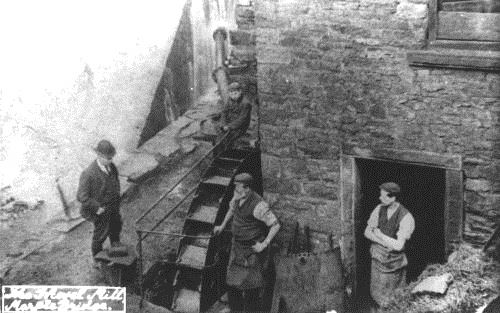Mellor between the wars – utilities and services
A visit to the well on "Coal Pit Lane",during a drought c1920.
Coal Pit Lane (now Edward Street) was opposite the Northumberland Arms, in Compstall.
Many amenities, now taken for granted, were completely lacking in those days. I am sure there was no telephone in Top Mellor so if there was an urgent need for a doctor a messenger had to dash down to the surgery in Marple Bridge. When I was born this is what my father had to do in the night and I believe he jokingly remarked that he only had time to put his bedroom slippers on. A phone  box put by the Devonshire Arms (right) in early 1920s was much appreciated. Apart from a sewer , up Longhurst Lane and through Moor End, there were no public services then in top Mellor. About 1925 the gas main was extended up the road from where it had finished at the Manor House. Premises on the road or near to it could connect up. Electricity didn’t arrive until the early 1930’s. Thus, in the period I am talking about, we managed with paraffin lamps and candles for lighting. This was no hardship or the lack of any public light on the road a problem. Everyone was used to moving about on dark evenings, perhaps using lantern or flash light when it was very dark. The lack of a proper public water supply was the biggest problem. The local authority took over 20 years to solve it before a water main connected Mellor with a spring below Kinder Scout at Hayfield. There were celebrations when the water was turned on in 1926. Before this time many cottages were without piped water and people had to collect their supplies in buckets from outside pumps or wells. Various landlords had small private supplies for their tenants but these were insufficient in dry summers. Our supply was piped from a spring in the fields above and when it dried up we then had to take buckets up the fields to a pipe feeding a cattle trough with a slow dribble of water. Baths had to be postponed at those times. Unlike most of the cottages we did have a bathroom with hot and cold water. It had been partitioned off from one of the bedrooms.
box put by the Devonshire Arms (right) in early 1920s was much appreciated. Apart from a sewer , up Longhurst Lane and through Moor End, there were no public services then in top Mellor. About 1925 the gas main was extended up the road from where it had finished at the Manor House. Premises on the road or near to it could connect up. Electricity didn’t arrive until the early 1930’s. Thus, in the period I am talking about, we managed with paraffin lamps and candles for lighting. This was no hardship or the lack of any public light on the road a problem. Everyone was used to moving about on dark evenings, perhaps using lantern or flash light when it was very dark. The lack of a proper public water supply was the biggest problem. The local authority took over 20 years to solve it before a water main connected Mellor with a spring below Kinder Scout at Hayfield. There were celebrations when the water was turned on in 1926. Before this time many cottages were without piped water and people had to collect their supplies in buckets from outside pumps or wells. Various landlords had small private supplies for their tenants but these were insufficient in dry summers. Our supply was piped from a spring in the fields above and when it dried up we then had to take buckets up the fields to a pipe feeding a cattle trough with a slow dribble of water. Baths had to be postponed at those times. Unlike most of the cottages we did have a bathroom with hot and cold water. It had been partitioned off from one of the bedrooms.
There was no source of heat in the top part of the house and in winter, as a child, I was bathed in a tin bath before the kitchen fire. Winter mornings in the top part of the house were somewhat Arctic but the frost patterns on the windows were beautiful and different every morning. The bottom rooms, with the exception of what we called “the sitting room,” had stone flagged floors covered with linoleum and coconut matting. The sitting room had a square of well-worn carpet over the wooden floor. Generally the only source of heat was the fire in kitchen range. Only at weekends and holidays, and perhaps on special occasions, was the sitting room fire lit. Central heating and fitted carpets were unheard of.

John Rowbottom, village Blacksmith at Moor End
Much of the old rural life of a farming community remained. All farms kept milking cattle and crops such as potatoes, turnips, kale, barley and oats were grown. The farmers were able to supply the whole district with milk. There were no milk bottles then and nothing came in from outside. A large quantity was taken by horse drawn milk float to Marple Station in big cans, consigned to Manchester Dairies. There were many allotments and back gardens where vegetables and fruit were grown. These were generally well looked after and quite productive. The countryside then had a much tidier look than now. Hedges were trimmed, walls kept in repair and field drains looked after. There were no cars that I can remember in the Top End. People moved about on foot and field paths were well maintained with regular dressings of cinders which kept them free of mud. These were the shortest routes between places and were well used.
 In the first settled weather of July the clatter of horse-drawn mowing machines could be heard in the meadows, often starting at dawn light and continuing until nightfall. Then came the tedding or tossing of the hay, raking up into long heaps and loading with hay pikes onto carts. A flat frame was fitted around the top of the cart to give a larger base to carry a big pile of hay. Generally a man rode on the top to keep the hay down as it was taken to the barn or stackyard. This getting in of the hay was almost a social event, with neighbours joining in. No payment was expected but the farmer was supposed to provide beer and some food. My father enjoyed helping in the adjoining meadow and I liked being there too. Hay is lovely stuff to play around with and I must have been into most barns in the district. In early summer the meadows were full of flowers and sweet scents, and there was the rasping call of the corncrake which disappeared from here long ago. Hedgerow flowers were more abundant and I remember all the wild roses along Gibb Lane.
In the first settled weather of July the clatter of horse-drawn mowing machines could be heard in the meadows, often starting at dawn light and continuing until nightfall. Then came the tedding or tossing of the hay, raking up into long heaps and loading with hay pikes onto carts. A flat frame was fitted around the top of the cart to give a larger base to carry a big pile of hay. Generally a man rode on the top to keep the hay down as it was taken to the barn or stackyard. This getting in of the hay was almost a social event, with neighbours joining in. No payment was expected but the farmer was supposed to provide beer and some food. My father enjoyed helping in the adjoining meadow and I liked being there too. Hay is lovely stuff to play around with and I must have been into most barns in the district. In early summer the meadows were full of flowers and sweet scents, and there was the rasping call of the corncrake which disappeared from here long ago. Hedgerow flowers were more abundant and I remember all the wild roses along Gibb Lane.
My earliest recollections in life were associated with my mother and I remember hiding behind her when an elderly woman tried to make a fuss of me. I also remember visits to Marple Bridge. Mother, of course, would walk and I suppose I would be pushed in my pram at first. There was much of interest in Marple Bridge. The spade forge was operating and sparks could be seen through the open door. A horse-shoeing forge on the riverside of Town Street also interested me greatly but I was scared of the river which carried more water in those days and fell over the weir with a loud roar. The waterwheels of the corn mill were generally turning to provide another feature of interest.
Spade Forge Mill, Marple Bridge

The top end of Mellor was a self-contained community and most outings took us to the shops up there. The most important shop was Potts Store which is still a store but with another name. In those days it seemed to sell everything , food, groceries, household utensils, footwear and clothing. It had been established by Alfred Potts and was operated by his sons, Wilfred and Harold. My mother bought our groceries from here. She would call weekly to pay for her last week’s purchases and leave her grocery book with her next order written in it which would be delivered to our door by Potts carrier. Lewis Potts, another of the sons, had a butcher’s shop across the road and I was fascinated to watch him chop meat without losing a finger or thumb in the process. There was an ironmongers’ just above the Oddfellows Inn which, in addition to selling ironmongery, sold sweets of the cheapest variety. We generally bought our pear drops, wine gums and gob stoppers here. There was a greengrocer’s at Spring Bank, a bakery and shop in Podmore Lane, Bradburys‘ butchers and post office in New House Hill, a cobblers shop at Sun Dial and two small toffee shops. Old George Pott was a joiner, wheelwright and undertaker and John Rowbottom (above) a blacksmith and seller of paraffin oil.


